On the Janis line of my family tree, focusing on the 18th Century, and with a guest appearance by a distant cousin
Introduction
This webpage and the next owe their genesis to François Oulette, a distant cousin who contacted me in September of 2023. He was doing his own genealogical research, focusing on François Janis, an early settler of Detroit. His investigations had led him to my pages on Jean Baptiste Janis, my ancestor whose participation in the American Revolution is explored in Jean Baptiste Janis, Pt. 1 and Jean Baptiste Janis, Pt. 2. It turned out that my distant cousin's François Janis was Jean Baptiste's uncle; that is, Jean Baptiste's father, Nicolas, was François' brother.
In fact, our research hardly overlaps at all. From 2023, the year in which François Oulette contacted me, you have to go back 357 years to reach the point at which our genealogies merge—to the 1676 birth of François Janis, Senior, our common ancestor. Nevertheless, François Oulette's email gave me the impetus to learn more about the Janis side of my family, and it gave me an excuse to, if not resolve, at least attempt to illuminate a mystery mentioned in the original version of my pages on Jean Baptiste.
When we merge our two Janis lines, this is what we have:
├── Jean Janis == Marie Paquet
├── François Janis (b. 1676) == Simone Brousseau (1684-1746)
|-- François-Eustache Janis (1713-1769) == Thérèse Méloche
(settled in Detroit)
|-- (... down to François Oulette)
├── Nicolas Janis (1720-1804) == Marie Louise Thaumur (1737-1791)
(settled in Kaskaskia, Illinois)
├── Jean Baptiste Janis (1759-1836)
├── (... down to me)
The mystery concerns the very question of whether François Oulette and I are related at all. A prominent genealogist/historian claims that it was Nicolas, not François, who married Thérèse Méloche and settled in Detroit. If this is true, then I cannot be the descendant of this Nicolas Janis, for my Nicolas Janis undoubtedly settled in, and became a prominent resident of, the village of Kaskaskia. I refer to this as "The Matter of the Two Nicolases," or "The Two Nicolases" for short. I'll have much to say about this in The Janis Line, Pt. 2, which follows this page. For now, let's cover what facts we can be more-or-less certain about.
The François-Eustache Side
François Oulette, Distant Cousin
As already mentioned, in September of 2023 a distant cousin and fellow amateur-genealogist performing his own genealogical research came across my website and reached out. Thus began a correspondence that has thus far continued through 2024. In this section I stitch together lightly edited parts of François Oulette's several emails to form what I hope is a coherent narrative. Direct quotations from François are indented with the line at the side; in normal typescript I paraphrase him, adding a few words or an explanation here and there. Oh, and a map stolen from Wikipedia.
Introductions
I just stumbled upon your website while doing some research on Nicolas François Janis. I was very happy to find such a treasure trove of information!
Since I’m currently doing my own research on my family, I thought I’d share with you some more information I found on the Janis family.
The Janis appear in my family’s tree in Detroit, or more precisely in Sandwich, which is across the Detroit River and is now part of Windsor, Ontario. Sandwich was the first white permanent settlement in the province of Ontario.
Wide-Ranging Brothers
François Janis the Elder emigrated to New France and was married to Simone Brousseau in Trois Rivières, Quebec in 1684. They had several children including four sons who all moved to different places.
- Jacques Jacob Michel (1711-1751) ended up in St-Landry, Louisiana.
- François-Eustache (1713-1769) made his way to Detroit.
- Nicolas François (1720-1804) went to Kaskaskia, on the Mississippi in modern-day Illinois.
- Antoine (b. 1708) remained in Quebec Province, and was involved in the fur trade business, organizing fur trading expeditions every year.
Both François and Nicolas were “voyageurs”, and were hired for the annual trip to the “Pays d’en haut” in the late 1730’s and early 1740’s.
An interesting detail that I noted: François Janis, the elder, died on 27 April 1751 in Detroit, the exact same day that his son Nicolas François got married in Kaskaskia! It seems that François, the elder, followed his son to Detroit in his later years.
Voyageurs (Wikipedia Link) were French Canadians who transported furs in the 1700s. In Canada they have been romanticized just as cowboys have been romanticized in our country.
The Pays d'en haut (best translated as the Upper Country; Wikipedia Link) was all of New France west of Montreal. You can think of it as the entire Great Lakes region, plus some more land further west. See the map below.
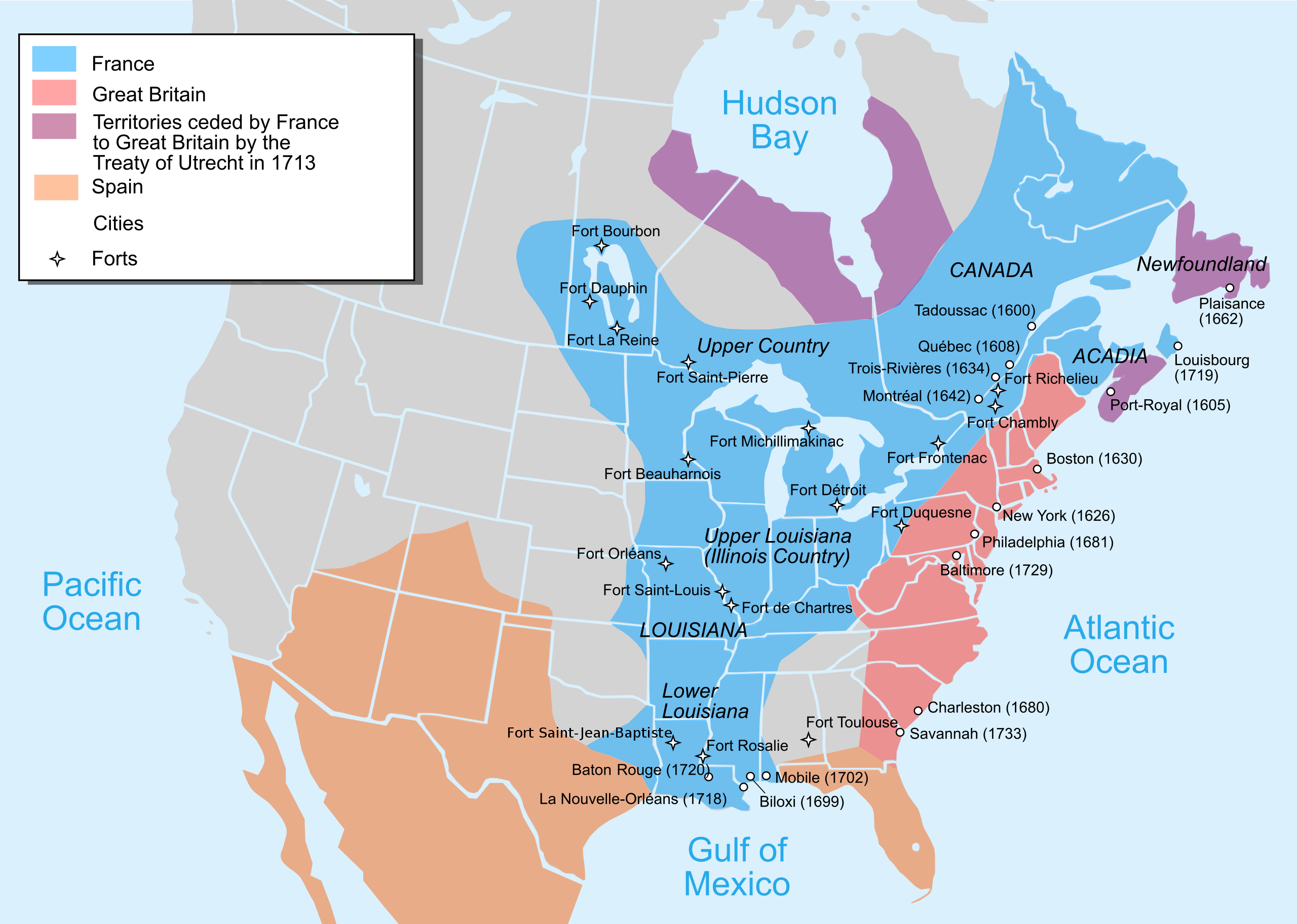
François Janis Acquires Land in Detroit
François Janis eventually settled in Detroit, and helped the Huron mission there, led by Father Jacques Potier. He is mentioned many times in Father Jacques Potier’s writings. He was the farmer for the mission, in other words taking care of their field. The mission was originally on an island a bit down river from the fort in Detroit, but moved just across the river about 1748. In 1750, the French King awarded many land grants to new settlers, both on the north and south sides of the Detroit River.

A few more grants were made in 1760, on the eve of the surrendering to the British. This is when my own ancestor (Jean-Baptiste Ouellette) arrived. On the map attached, which dates about 1796, lot no. 5 is Janis, spelled Janise, no. 6 is “Bouran", which was actually Bouron, and no. 7 “Gadette”, which is actually Ouellette. This was confirmed by the simple fact that J.B. Ouellette married Charles Bouron’s daughter, and his own son later married François Janis’ granddaughter. François was also godfather to his second son. So they were essentially neighbors. The Janis family grew and prospered in the Windsor area, as did the Ouellettes. Windsor’s main street today is Ouellette Street, located exactly where Jean-Baptiste’s land was. There were a lot of such cross-marriages between the settler families, as it was such a small place!
I [i.e., François Oulette] spent a lot of time trying to figure out how Jean-Baptiste Ouellette ended up in Detroit and Sandwich. The last land concessions were made in 1760, right before Detroit fell to the British in the fall. JB was there at the latest in 1762, since his marriage record in January 1765 states that he had been on his land for more than 2 years, and people didn’t travel in the winter. But he got his concession in 1760, so, how? My hypothesis is that he joined the French militia that defended the fort in Detroit, as the soldiers were promised land if they did. He was of age. His own village (and all those along the south coast of the St-Lawrence all the way to Québec City) had been burned by the British army in the summer of 1759, so he definitely had a motivation to join the fight! Now, all the officers and soldiers in Detroit were made prisoners and sent south (what is now the US), for a few months. The French officers were sent back to France, but I believe they just let go the local soldiers. He would then have been back to Detroit in 1761, with a land deed. I found out that in April 1762, the governor of Detroit wrote to the Governor General in Montreal, saying that settlers were asking him about their land deeds, and what should be done about them. He was told that if they were valid concessions, he should let the settlers have them. So I now believe that JB Ouellette was one of those who went to ask, and so occupied his land from the summer of 1762.
The history of Detroit during that period is also full of interesting events, from the cession of the fort in 1760, to Pontiac’s siege in 1763, and to later the War of 1812, when the Americans landed right across Detroit and were eventually repelled. These pioneers lived through all those events. Both François Janis and Jean-Baptiste Ouellette witnessed first hand Pontiac’s siege, as they were right across the river. There is an account of the siege that sheds a lot of interesting light on it.
Marriage and Death Records
In addition to the mini-histories quoted above, François Oulette sent me images of two documents related to François-Eustache.
Marriage of François and Thérèse Méloche
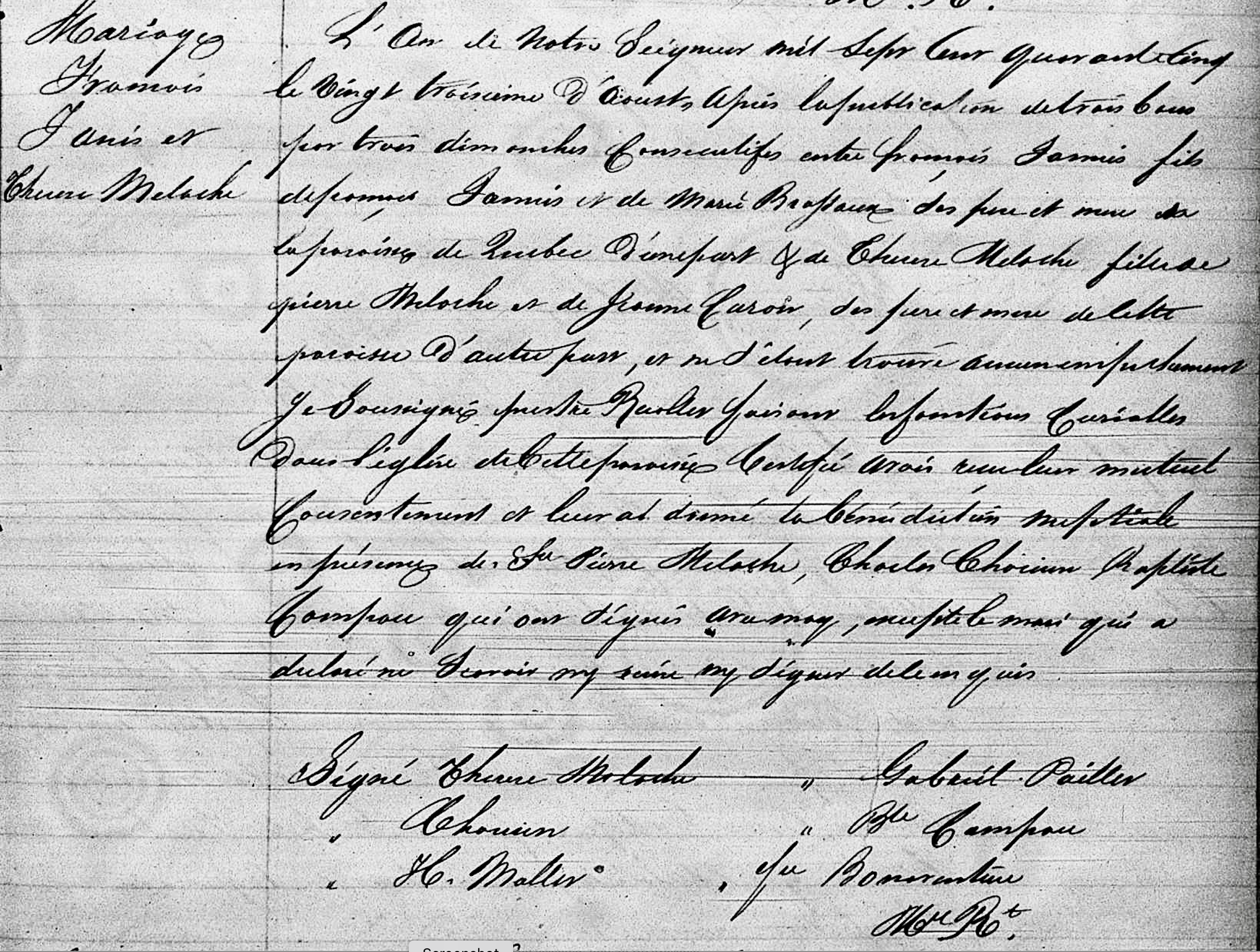
At right you'll find a screenshot of a marriage record for Francois Janis and Thérèse Méloche. To be honest, I find the penmanship pleasant to look at but not so pleasant to read; moreover, I have no background in reading 18th Century marriage records in French. For these reasons I decided I would not attempt a full transcription/translation. What I will do is go through it, transcribing enough of the phrases and words to verify that the record is what François Oulette says it is, and then I'll provide a translation of those same phrases and words into English.
L'An de Notre Seigneur mil Sept Cent quarante Cinq le vingt et troisième d'Aôut, Aprês la publication de trois bans sur trois dimanches Consecutives entre françois Janis fils de françois Janis et de Marie Reassaux/Beassaux des (...) de Quebec d'une part et de Thérèse Méloche fille de pierre Méloche et de Jeanne (...) de cette paroisse d'autre part et ne s'étant trouvé aucun empêchement (...) Je soussigné prêtre (...) dans l'église de Cette paroisse (...) mutuel (...) et leur ai donné la bénédiction nuptiale (...) en présence de (...) Pierre Méloche, (...) qui ont (...)
In the Year of Our Lord Seventeen Hundred Forty-Five on the 23rd of August, after the publication of three bans on three consecutive Sundays between François Janis, son of François Janis and Marie Brossaux from Quebec on the one hand and of Thérèse Méloche, daughter of Pierre Méloche and of Jeanne (...) of this parish on the other, and not having found any impediment (...) I the undersigned priest (...) in the church of this parish (...) mutual (...) and gave them the nuptial benediction (...) in the presence of (...) Pierre Méloche, (...) who have (...)
I provide the full image below. At the bottom you can see exactly where it was obtained.
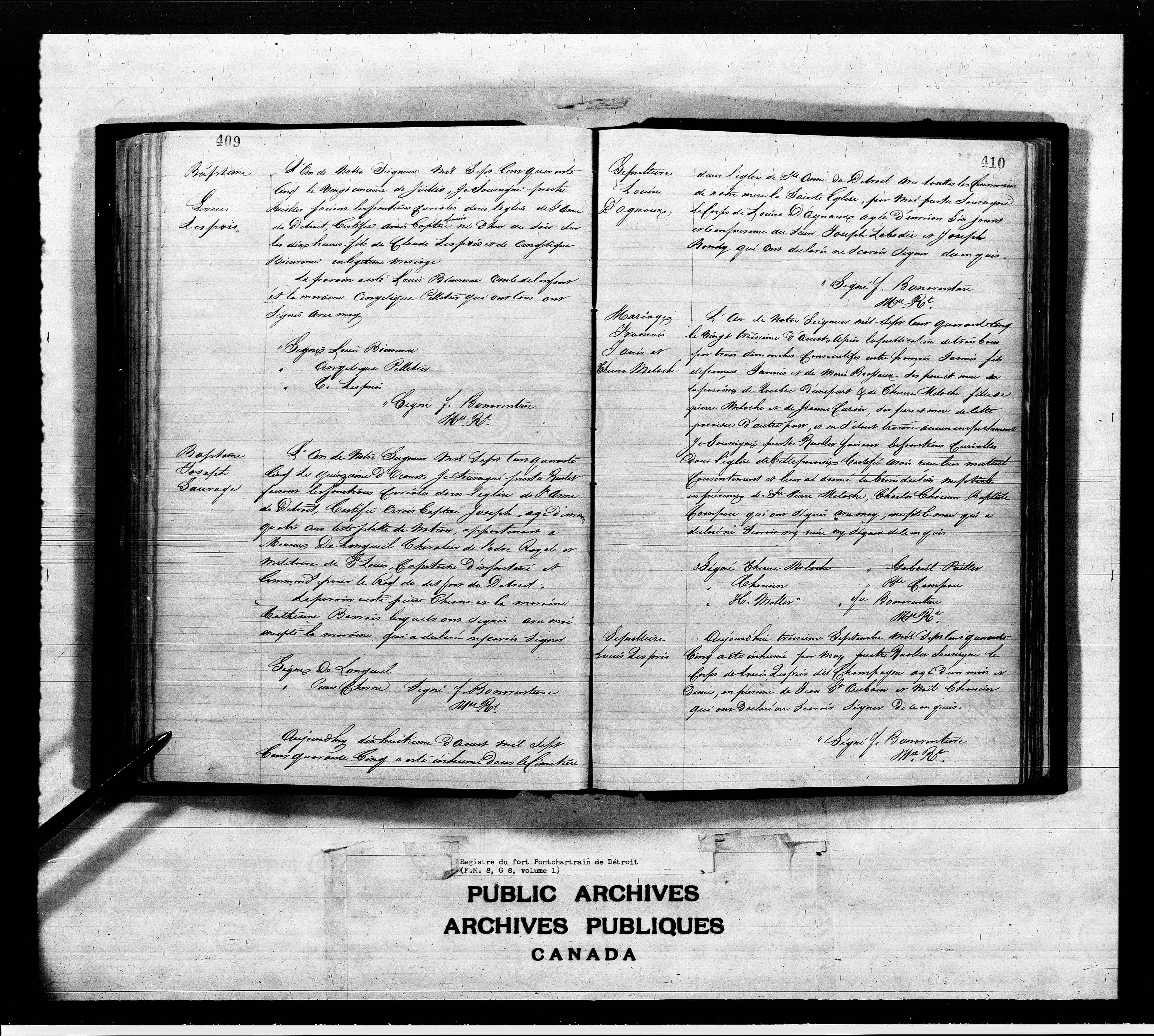
Just a few comments, if I may:
- François Janis' mother's name does not seem to be correct. It's supposed to be Simone Brousseau. My transcription of her surname as "Brossaux" is being generous. Originally I had "Reassaux/Beassaux." "Brossaux" is plausible because at least it sounds identical to the correct name "Brosseau." We can call the spelling of the last name a clerical error, but there is no way to turn whatever the priest has written for the woman's first name into Simone, her true first name. I have "Marie." It could be many other things. But it cannot be "Simone."
- There doesn't seem to be a mention of Detroit or Sandwich in this document, the place(s) where François-Eustache is believed to have married and settled. However, if you click on the link to enlarge the image, and then hit Ctrl-+ to enlarge it further, you will see at the bottom, in fine print above "PUBLIC ARCHIVES," these words which identify the source of the record: "Registre du fort Pontchartrain de Détroit".
- See Notes on the Transcriptions and Translations for how I approach the task of transcribing and translating the records on these pages.
François' Record of Death
From the paragraph highlighted in yellow in the image below:
aujourd'hui 16 Decemb: mil. sept cent soixante et neuf, a été inhumé dans L'église de l'assumption par moi, prêtre jesuit sousigné, le corps de françois janis agé environ 61 ans, après avoir reçu les sacrements de pénitence, d'eucharistie et d'extrême-onction.
pi: potier j.m.
On this day, the 16th December, 1769, was buried at the Church of the Assumption by me, the undersigned Jesuit priest, the body of François Janis, aged roughly 61 years, after having received the sacraments of Penance, Holy Eucharist and Extreme Unction.
Pièrre Potier, Jesuit Missionary

Notes:
- François Oulette has the priest's given name as Jacques, not Pierre. It's probably just a slip-up on his part, and I will correct it when he confirms the error.
- As we saw above, according to my distant cousin François Oulette, François Janis worked for Father Potier for many years. No doubt the priest mourned the loss of his yeoman, but the entry in the church record betrays not a hint of their close association.
Jesuit Missionary Documents
In my research I came across the online version of a book edited by Reuben Gold Thwaites, called The Jesuit Relations and Allied Documents 1610 to 1791. (The link goes to my notes on the publication, which include a link to the online publication itself; click on it if you want to learn more.) It's essentially a collection of much of the paperwork associated with the day-to-day operations in many of the Jesuit missions in New France—from daily expenses and contracts to journals some of the French priests kept... and more besides.
There are 71 volumes, all published in the 1890s, and from what I've seen the layout of each volume goes like this:
- First a preface in which the editor, Reuban Gold Thwaites, summarizes the contents of that volume.
- Then the contents themselves, consisting of English translations of many, many documents which were originally written in French or Latin by someone (usually a priest, I think) connected to a French mission. Occasionally Thwaites precedes the content with a few introductory remarks.
- Finally come the editor's notes at the end.
I am focusing on the editor's contributions because, with regard to the Matter of Two Nicolases, distinguishing between the original documents and the editor's comments thereon is crucial. To be clear, the editor was writing in the 1890s, while the documents he was commenting on were written roughly 200-350 years before—and I think Mr. Thwaites has made an important mistake.
I searched on "janis" in the last three volumes (69-71) and in Volumes 69 and 70 I found some hits.
For Volume 69 I found:
- Several mentions of a person named "janis" as owing or being owed some amount of money for a service. These occurred in two documents: "ACCOUNT-BOOK OF THE HURON MISSION OF DETROIT; BEGUN ON THE FEAST OF ST. JOHN, 1740," and "CONTINUATION OF THE BOOK OF ACCOUNTS OF THE HURON MISSION ON ÎLE AUX BOIS BLANCS FROM THE 30TH OF JULY, 1746, THE DATE OF FATHER DE LA RICHARDIE’S DEPARTURE."
- In the editor's Note 71 at the end, these lines (with no citation):
Nicolas François Janis, born at Quebec, in 1720, a master-mason by trade, settled at Detroit. In 1745, he married Thérèse (daughter of Pierre) Méloche, then thirteen years old, by whom he had eight children. The date of his death is not recorded.
In the first paragraph, concerning the mentions of "janis", we find ourselves in the very Huron Mission that played a central role François Oulette's account of François-Eustache's work in Detroit (see François Janis Acquires Land in Detroit, above).
In the second paragraph the editor, Mr. Thwaites, provides some historical background on a person who lived a couple of hundred years earlier, to the effect that Nicolas François Janis (and not his brother, François-Eustache) went to Detroit and married Thérèse Méloche. But it's important to observe that the writer(s) of the documents themselves do not specify the given name of the person referred to as "janis." In Volume 69, the man's full name is not once provided.
In Volume 70 I found more mentions of "janis":
- In the editor's Preface for the volume, which reads:
In the summer of 1751, “Niagara” Campeau cesses [sic] to work the mission farm, and is succeeded (September 1) by Nicolas F. Janis. The terms of settlement with the former, and the contract made with the latter, are given in detail. This ends the “book of accounts.”
- Many mentions of "janis" as owing or being owed some amount of money for a service. No first name is provided.
- A contract, quoted verbatim, between the mission and (probably the same) someone named "Janis." The contract begins, "Janis took The farm of the huron mission of detroit on The 1st of September, 1751." The contract ends, "Signed, Armand de La Richardie, jesuit Missionary; janis, not knowing how to write, has made a cross, +."
- In a document titled "BAPTISMS AT THE HURON MISSION, 1752-56":
This day I baptized françois, recently born of the Marriage of Louis viller and Marie josephine Marin; the sponsors were français janis and Marguerite La Durantaye . January 1, 1753. Pierre Potier, jesuit Missionary.
Except for the first name of the Janis involved, the first bullet point above for Volume 70 would agree with François Oulette's account. Note that this bullet point was written by the editor. The next two come from the original documents, and they both refrain from specifying the first name of the Janis concerned—not even the contract gives it! But the fourth bullet point, also from an original source, at last gives the full name, "français janis." And this is too close to the name François to read it any other way.
To sum up, regarding the identity of the "Janis" mentioned in these two volumes:
- In the original documents he is identified only as "janis" or "français janis."
- He is identified as Nicolas Janis only in the editor's notes.
In other words, the documents support the contention that Francois-Eustache settled in Detroit, not Nicolas Francois Janis. The editor, Reuben Gold Thwaites, must have obtained his erroneous information from some source emerging at a point in time in the intervening two centuries.
The Nicolas Side
It's six generations back from my mother, Corinne AuBuchon Kurlandski, to Jean Baptiste Janis, whose father, Nicolas, was the brother of François, the brother who settled in Detroit. Here's the lineage from our original AuBuchon AuBuchon Family Tree.
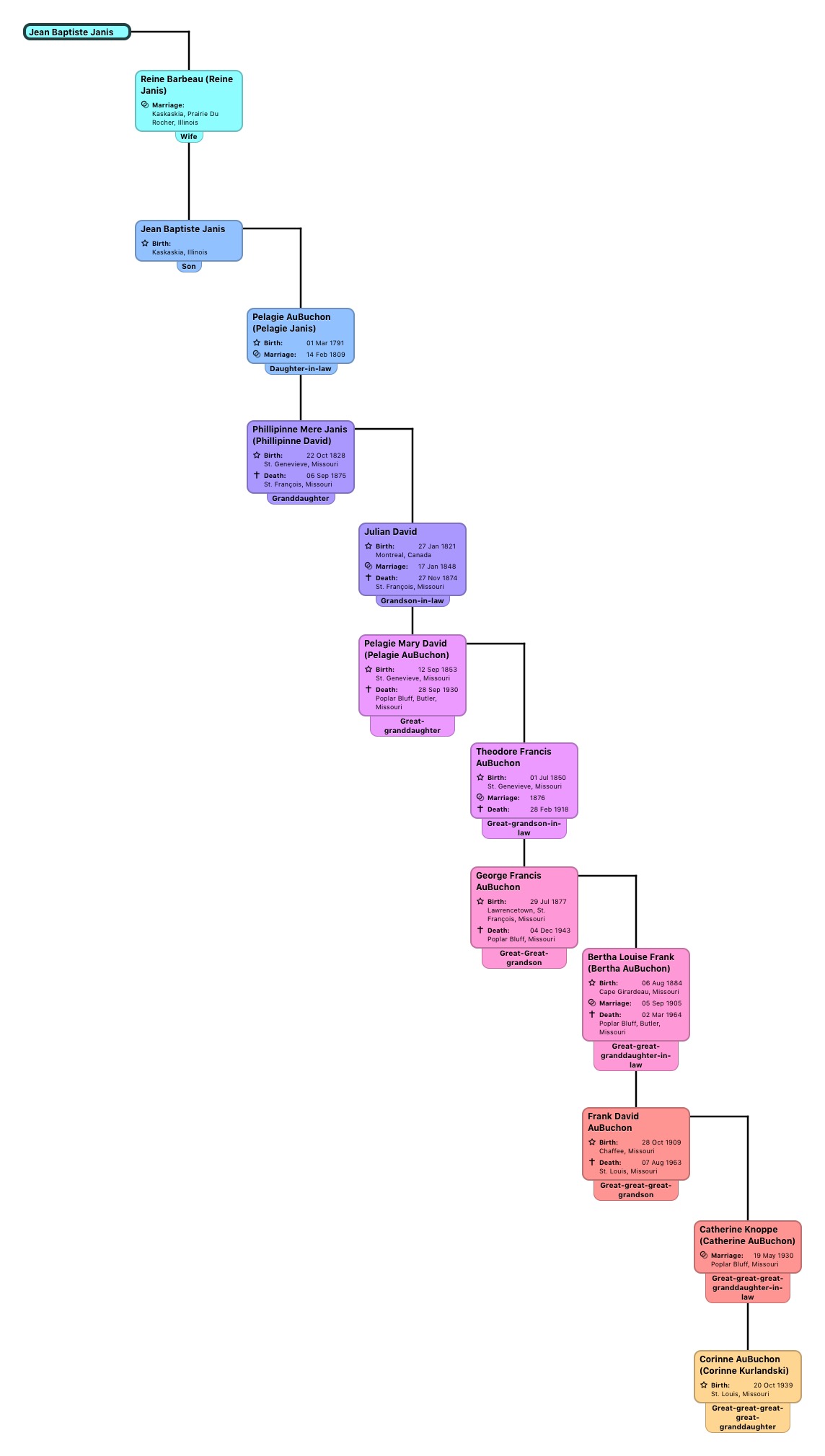
Probably the easiest way to see the tree is to open it in a separate tab by right-clicking on the link below it. Hopefully when that window opens you'll see a plus sign that you can click on to make the image larger.
This style of family tree is color-coded by generation, so that any individual's parents are the same color. In other words, Jean Baptiste Janis and Reine Barbeau—both the same shade of light blue—had a son who was also named Jean Baptiste Janis, who is in a darker shade of blue. When necessary, I'll distinguish the two Jean Baptistes by calling them Jean Baptiste the Elder and Jean Baptiste the Younger (or Jean Baptiste père and Jean Baptiste fils, depending on my mood).
Working on this "Janis Line" page has given me a lot of new information. Rather than modify the original tree, I have created a separate tree for the Janis line with this new information.
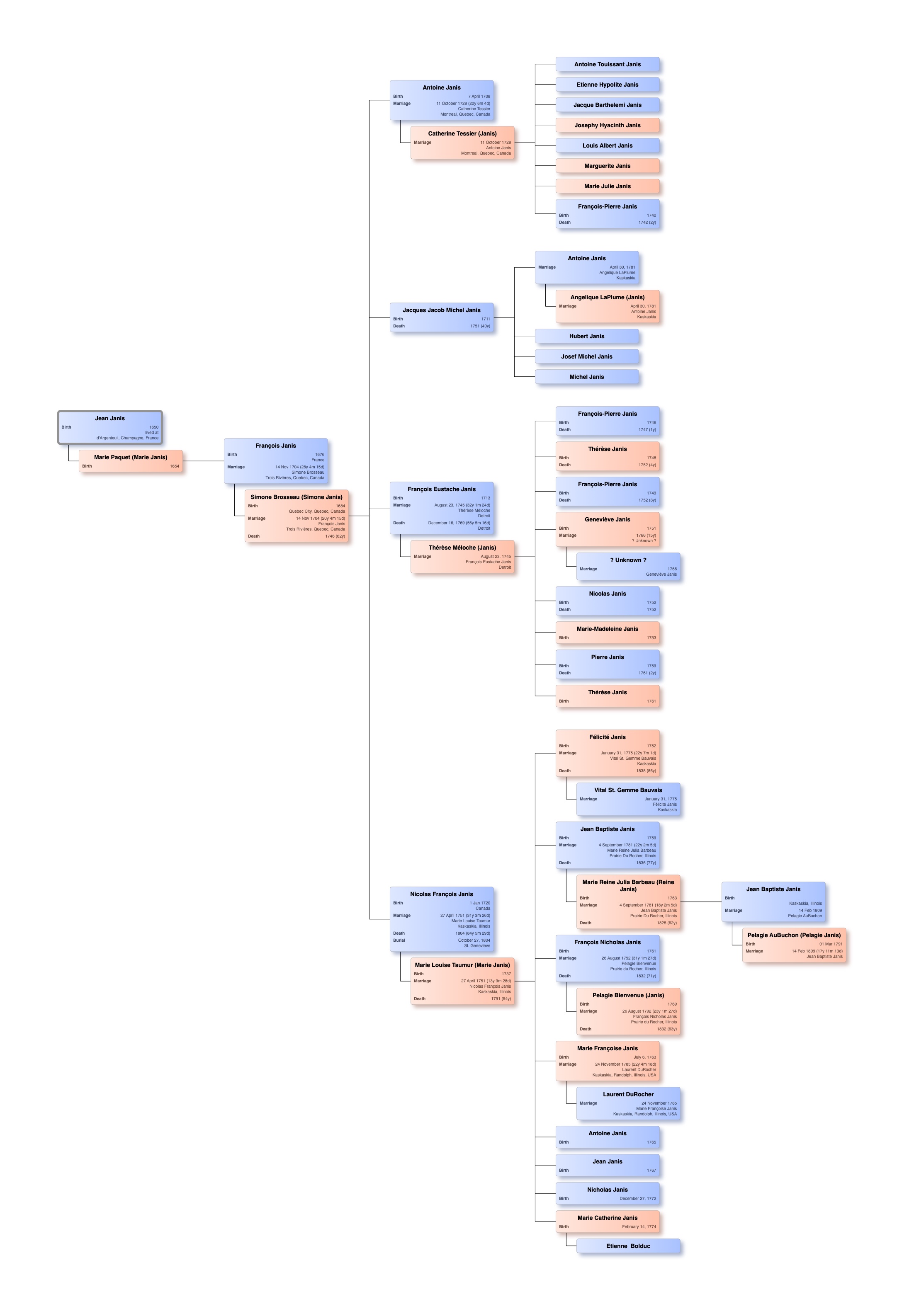
You see that most of the new information concerns the second and third generations in the tree. If you're lost about how this fits into the original tree, look at the right-most node&mddash;Phillipine Mere Janis married a man whose surname was David, and it is their line that eventually led to my mother and myself.
A good part of this new tree comes from "Almost 'Illinark': The French Presence in Northeast Arkansas," where George E. Lankford writes of Nicolas, the brother of François Oulette's François Janis:
Nicholas Janis was an important man both in French Illinois and in his family, as his consistent signature suggests; it is always just “Janis,” without further specification.
He had six known children, and it was hypothesized that there was a seventh. They were Jean Baptiste (1759-1836), François (1761-1832), Antoine, Catherine, Félicité (ca. 1751-1837), and Françoise. Their marriages read almost like a survey of significant families of French Illinois: Jean Baptiste married Reine Julia Barbau; François married Pélagie Bienvenu; Catherine married Etienne Bolduc; Félicité married Vital St. Gem Bauvais; and Françoise married a Durocher. (p. 96-97)
Research Approach
What I would like to do is cover Nicolas Janis in the same way that I wrote about his son, Jean Baptiste, in my two pages related to the younger man and the Battle of Vincennes. That is, as a short biography. I would like to, but I can't.
I can't because, for Jean Baptiste, I was able to draw from other biographical texts, chiefly Lankford, while, as far as I know, there is no pre-existing biography on Nicolas Janis. The younger man had fought in a crucial battle in the Revolutionary War. The father lived in a time, place and culture most Americans know absolutely nothing about, and which even historians have neglected.
Biography is what they call a secondary source, and it is based on primary sources such letters, diaries and birth records. Secondary sources interpret and contextualize primary sources. (See History: Primary vs. Secondary Sources.) When I realized I didn't have enough material for a mini-biography, it became clear that I would have to do the leg-work of searching for primary sources.
Well, I've now done the leg-work. I now have a long list of primary sources concerning my ancestor, Nicolas Janis, who spent much of his life in Kaskaskia, then later moved across the Mississippi River to Ste. Genevieve. Unfortunately, that's all I have—just a long list of primary sources, with very little of the interpretation and contextualization of a secondary source. In other words, if it's interesting to anyone at all, it is unlikely to be interesting to anyone but a genealogist or historian. It's a long way's away from a riveting read. To make it all a little more bearable, I've tried to spice up each primary source with a little bit of home-made commentary.
Primary Sources
All my primary sources come from FamilySearch.org. Membership at FamilySearch.org is free, but my links to the website won't work if you haven't registered and logged in. (Don't worry if you aren't a member, however: I provide all the information you need below.)
Nicolas's page there is located at https://www.familysearch.org/tree/person/about/LVY2-1LB. Near the top are four tabs: About, Details, Sources, Collaborate, Memories and Time Line. All but one of the records listed below can be found under the "Sources" tab. You can view each record by clicking on it and then clicking on the link.
Nicolas François Janis Baptism
Full Title: Nicolas François Janis baptism 7 January 1720, Notre Dame, Quebec, Quebec, New France parish register
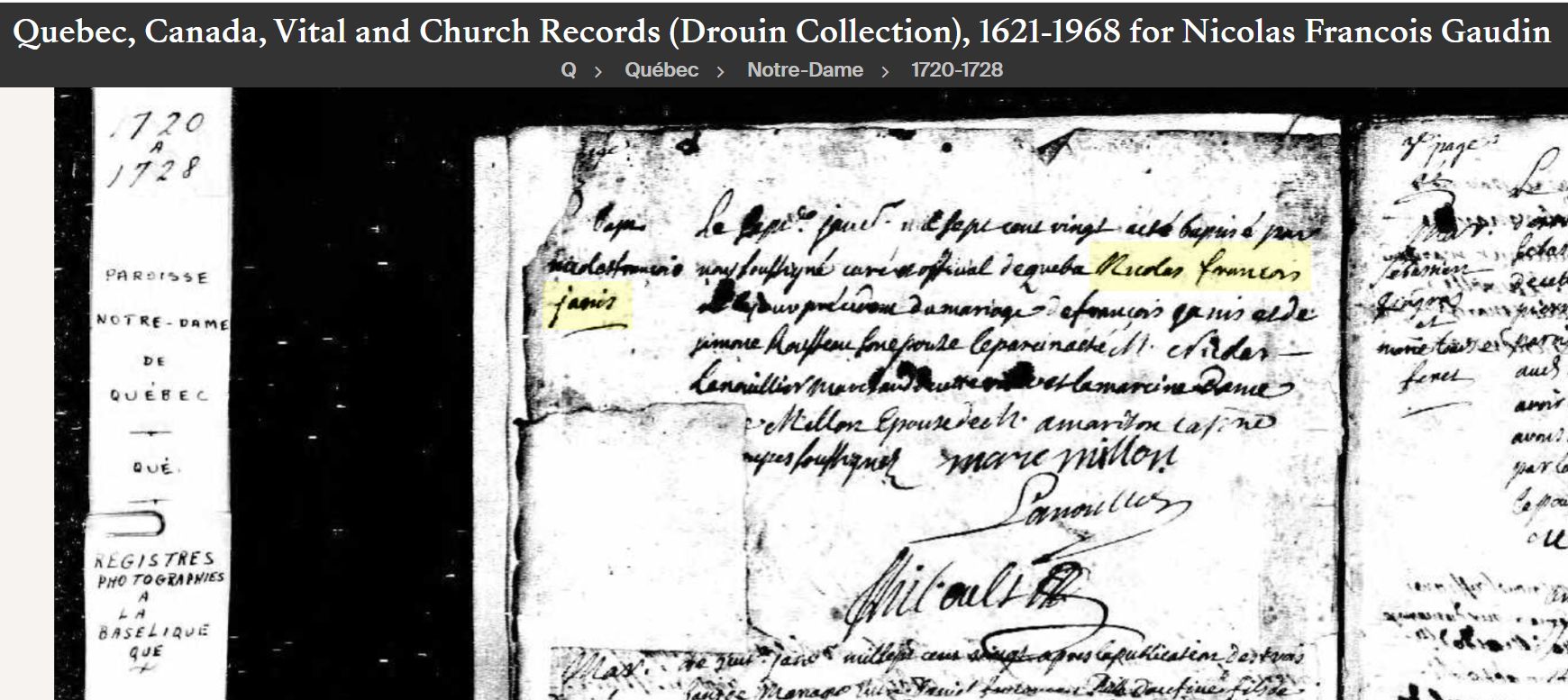
Notes
1. Metadata attached to this record has it as documenting Nicolas Janis's birth to François Janis and Simone Brousseau, but the heading on the image says it's about "Nicolas Francois Gaudin."
2. Moreover the record itself is so illegible it could almost serve as a Rorschach test—whatever genealogical claim you wish to establish, however far-fetched it may be, feel free to find documentary evidence of it here.
3. In the record Nicolas's mother's name appears to be spelled as Rousseau rather than Brousseau.
Marriage of Nicolas and Marie Louise
Full Title: 27 April 1751 marriage of Nicolas Jannice, son of the late François Jannice & Simone Brussant, and Marie Louise Tumaur, daughter of Jean B. Taumur dit LaSource, former officer of the militia, & Marie Francoise Rivart, of this parish. Catholic Parish R...

It would have been nice if somebody at FamilySearch.org had transcribed the text. But as nobody has, it appears that I will have to, though I find the handwriting at times hard to make out, and—as I have already mentioned—I have no background in reading 18th Century marriage records in French. First comes the transcription, then the translation.
And thanks to these web pages for the crash course in 18th Century marriage records in French:
- https://www.familysearch.org/en/wiki/img_auth.php/7/7a/1-French-Canadian_Marriage_Records-Instruction.pdf
- https://habitant.org/joyeuse/Amiot%20Couvent%20Complete%20Article%20Translated%20and%20Bookmarked..pdf
- https://french-genealogy.typepad.com/genealogie/a-french-genealogy-glossary.html
- https://www.familysearch.org/en/wiki/French_Genealogical_Word_List
Le 27 Avril après avoir publié deux bans de mariage avec dispense du troisieme entre Nicolas Jannice fils de feu Francois Jannice et de Simone Brussaut, et Marie Louise Taumur fille du Sieur Jean B. Taumur dit La Source ancien officier de milice et de Marie Françoise Rivert de cette paroisse. J'ai reçu leur mutuel consentement de mariage et leur ai donné la benediction nuptiale suivant les regles de l'église en presence des temoins soussignés fait au Cascascias (?) le jour et an que dessus en la maison de—le curé.
On the 27th of April, after having published two marriage bans (dispensing with the third) between Nicolas Jannice, son of the deceased François Jannice and of Simone Brussaut, and of Marie Louise Taumur, daughter of Sir Jean B. Taumur dit La Source, former officer of the militia, and of Marie Françoise Rivert of this parish. I have received their mutual consent of marriage and have given them the nuptial benediction according to the rules of the Church and in the presence of the undersigned witnesses made in Kaskaskia (?) the day and year above in the house of—the pastor.
Notes

1. I needed multiple restarts and a lot of squinting to extract "Cascascias" from the handwriting, and I'm still not entirely sure I have it right. But I think I do. A little googling has verified there were many alternate spellings for Nicolas's village in the Illinois Country; Wikipedia lists: Kasklas, Kaskasky, Cas-caskias, Kasquskias, and Kaskaskias. You can see that part of the difficulty in interpretation is due to the writer's joining all three words (aux Cascascias le) with a pen stroke. Also, note the use of the long "s" which you can sometimes find in 18th Century documents and which resembles the letter "f."
2. Speaking of alternate spellings, notice the spelling of Janis as "Jannice." This makes me think that the "s" at the end of the surname might not have been silent. (Although Tanguay's alternate spelling of "Gany"—see Image 1 of the two screenshots from Tanguay in "The Janis Line, Pt. 2"—suggests that the "s" was silent.) Could the French speakers in the town have used both pronunciations?
3. And, still on the topic of alternate spellings, notice that the maiden name of Nicolas's mother is spelled "Brussaut," whereas most sources have "Brosseau." To an English speaker the difference may look significant; but in French they would be pronounced similarly, since the "t" at the end of the former is silent.

4. Note the different handwriting styles in this snippet from the document. The curé (Father Aubert) has written "le curé" at the top left in his workmanlike style. This is followed by Nicolas's signature, "Janis." Then we have the bride's "M. Taumur," followed by her father's rather elaborate "Lasource." As Lankford points out in the quotation given above, it is Nicolas's habit to use just his surname in his signature, but if you return to the complete image of the document you see that he is far from alone in having this peccadillo. Perhaps Lankford was mistaken in attaching to the habit an indication of the man's importance in local affairs. On a more aesthetic level, Marie Taumur's "M" is fairly pretty, but her surname isn't horizontally aligned and is not nearly so well practiced as her initial. Still, at least she appears to be literate; one isn't quite so sure with her new husband's signature, which actually looks misspelled. It would not be out of the ordinary for him to be unable to read and write: Nicolas's brother couldn't sign his name, as we learned in a priest's note on this very page in Jesuit Missionary Documents. Furthermore, I believe that the spelling issue described in Point 3 above provides very strong evidence that Nicolas was illiterate. One can easily imagine the following conversation as Nicolas and the curé prepared for the marriage.
Father Aubert (with pen in hand and a document on the table in front of him): And what were your parents' names, Monsieur?
Nicolas: François Jannice and Simone Brosseau, Father.
Father Aubert (writing): François Jannice ... and Simone?
Nicolas: Brosseau, Father.
Father Aubert: B-R-U-S-S-A-U-T?
Nicolas: Yes, Father. That's correct.
5. Why did the Curé dispense with publishing the third ban? My very brief research suggests this should occur infrequently. For example, The Catholic Encyclopedia offers some reasons that could justify dispensing with all or some of the bans: "fear of a malicious thwarting of the intended marriage" or the imminent death of one of the parties, as well as "notable difference of age, or condition of life; peril of the good name of either party; the approach of Advent or Lent, when marriage cannot be solemnized; notable temporal or spiritual detriment; imminent departure of the bride-groom; etc." At first I thought the approach of Lent might have had something to do with our particular case, but April 27th would have occurred either during or after Lent, not before it. (US Census data confirms this—Easter took place on April 11th in 1751.)
6. daughter of Sir Jean B. Taumur dit La Source: In this context dit should be thought of as meaning "called," and it indicates a kind of nickname that eventually became formal. See dit names.
7. In Wide-Ranging Brothers François Oulette reports that Nicolas was married in Kaskaskia on the same day his father died in Detroit. But here, in Nicolas's marriage record, his father is described as feu (deceased). It is not possible for the news of his father's passing to have reached southern Illinois from Detroit on the same day in which it occurred. To my mind, the only way to reconcile these two is if his father was very ill for several days at least, and word was sent to Nicolas that his father would surely be dead by the time he received the news, and in fact his father held on much longer than anyone in Detroit anticipated.
Baptismal Record of Jean Baptiste Janice
Full Title: 18 Sept 1759 baptism of Jean Baptiste, born today, son of Nicolas Janice & Marie Louise LaSource. Godparent Jean Baptiste LaSource & Catherine Bauvais. Catholic Parish Records, 1729-1956

Le 18 7bre j'ai Baptisé jean Baptiste né aujourd'hui du légitime mariage de Nicolas janice et de Marie Louĩse La Source. Son parrain a été le l (?) jean Baptiste La Source, et la maraine Catherine Bauvais. Le parrain a signé avec moi, et la maraine a fait la marque.
Today the 18th October I baptized Jean Baptiste born today from the legitimate marriage of Nicolas Janice and Marie Louise La Source. His godfather was Jean Baptiste La Source, and his godmother Catherine Bauvais. The godfather has signed with me and the godmother has made her mark.
Notes
1. This record gives us yet another way to (mis)spell Janis.
2. Note also the free use of Jean B. Taumur's nickname "La Source" in place of his surname, even to the point that it's assigned to his daughter.
3. Finally, notice the use of digit + "ber" in month names in French: "September is 7ber, October is 8ber, and November is 9ber" (https://theswisscenter.org/records). For this to make sense, you have to think of septagon, octagon and nonagon. By extension, you would infer "10ber" must refer to December, and Wikipedia agrees. I don't recall ever seeing this before.
Baptism of Marie Françoise
Full Title: 6 July 1763 baptism of Marie Françoise, born today, daughter of Nicolas Janice & Louise LaSource. Godparents Antoine LaSource & the spouse of Fagot, officer.
Note
1. The variations on the alternate ways of spelling Nicolas's last name are now: Jannice: 1, Janice: 2.
Baptism of Antoine
Full Title: 22 March 1765 baptism of Antoine, born 21 March 1765, son of Nicolas Janice & Marie Louis Thomure, habitants of this parish. Godparents Antoine Bauvais & Therese Lachapelle, habitants of this parish.
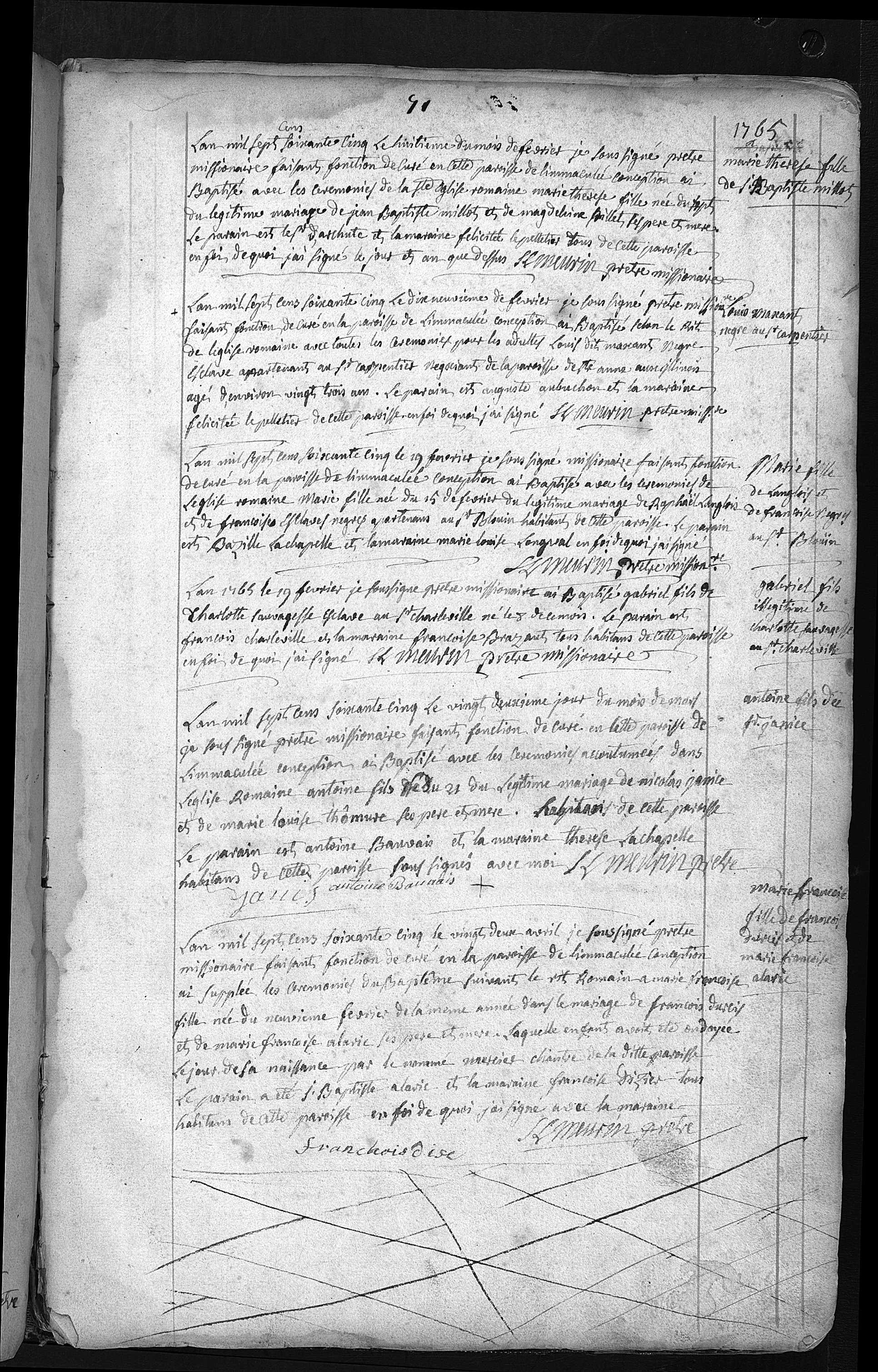
Notes
1. Antoine's baptismal record is fifth from the top.
2. Marie Louise's surname is spelled "Thômure" rather than Taumur, as on her record of marriage.
3. It appears that Father Aubert has been replaced by a new pastor, whose name I can't make out.
4. Nicolas's "janis" signature is far more certain than previously. His is the one closest to the lefthand margin. Compare it to the signature of his marriage contract at Marriage of Nicolas and Marie Louise. It's been 14 years since he shakily signed his marriage contract. He is 45 now.
5. The official records now lean in favor of "Janice" as the preferred way to spell Janis.
Baptism of Nicolas
Full Title: 28 Dec 1772 baptism of Nicolas, born the day before [27 Dec 1772], son of Nicolas Janis & Marie Louise Taumur LaSource. Godparents Louis LaSource, uncle, & Felicite Janis, sister of the infant. Notes 1. The baptismal record for Nicolas, Junior is fourth from the top. 2. This is the first church record which we have encountered written by the famous Father Pierre Gibault (Wikipedia). 3. From this point on, the Janis surname is always spelled correctly. Two years later Nicolas père will be identified as captain of the militia--perhaps the spelling correction is an indication of his rising stature in the town. Or the correction could simply be thanks to a newly-arriving, slightly more literate, curé. Full Title: 17 Feb 1774 baptism of Marie Catherine, born 14 Feb 1774, daughter of Nicolas Janis, captain of the militia, & Marie Louise LaSource. Godparents Jean Bte. Charleville, officer of the militia & Marie Catherine Giard, spouse of Cerre. Le Dix sept fevrier mil sept cent soixante quatorze par nous prêtre missionnaire faissant les fonctions Curiales en la paroisse de L'immaculée Conception De notre Dame Des Kaskaskias soussingé ont été supplées Les Ceremonies Du Baptême a marie Catherine ondoyée par nous même à Cause Du Danger, née Le quatorze Du présent mois Du légitime mariage Du M. nicolas Janis Capitaine De milice Et De marie Louise LaSource son Épouse. Le parain Jean Bte. Charlesville officier De milice Et la maraine marie Catherine Giard Épouse Du M. Cerré (?) Lesquels ont signée avec nous aussi (?) que le père present. On the 17th of February 1774 we, the undersigned missionary priest performing our pastoral duties in the Parish of the Immaculate Conception of Our Lady of Kaskaskia, have provided the baptismal rites to Marie Catherine, baptized by ourselves because of the danger [she was in], born on the fourteenth of this month of the legitimate marriage of Monsieur Nicolas Janis, captain of the militia, and of Marie Louise LaSource, his wife. The godfather was Jean Baptiste Charlesville, officer of the militia, and the godmother was Marie Catherine Giard, wife of Monsieur Cerré (?), who have signed with us (?) the attending priest. Notes 1. Marie Catherine's baptismal record is fourth from the top. 2. I don't know what kind of "danger" she was in when born, but you'll be reassured to learn that a cursory lookup on FamilySearch.org indicates that she lived a long life, marrying a certain Stephen (or Etienne) Bolduc and dying at the age of 83 in St. Louis. Full Title: 31 January 1775 marriage of Vital Ste. Gemme Beauvais, native of this parish, son of the late Jean Bte. Ste. Gemme Beauvais & Marie Louise LaCroix, AND Felicite Janis, also of this parish, daughter of Nicolas Janis, captain of the militia, & Marie Louise Taumur LaSource. Notes 1. Félicité's marriage record starts at the bottom of the left-hand side and continues to the right-hand page. 2. Notice how shaky Nicolas's signature is. It's worse than his signature on the wedding contract in the Marriage of Nicolas and Marie Louise section. From his own 1751 marriage until Félicité's here, we've been able to watch his signature mature: see Baptism of Antoine, Baptism of Nicolas, and Baptism of Nicolas. And now this dramatic regression. When he signed this, was he very drunk? Very ill? The next signature we have was for Marriage of Antoine Janis, an event that didn't take place until six years later. Let's hope it didn't actually take him that long to recover. Full Title: Note: Nicolas Janis was elected justice - Kaskaskia Records from 1778 to1790 1. This source differs from most of the others in that it links to a full-length book, Kaskaskia Records (1778-1790), edited by Clarence Walworth Alvord and published in 1909. The volume consists of a collection of correspondence and other documents from Kaskaskia for those years, and—since during this time Nicolas served both as captain of the militia and as a magistrate—many of these primary sources concern him directly or tangentially. On the "Sources" tab for the Nicolas Janis page at FamilySearch.org, many of the other links which follow are also from this book. 2. In the metadata from this source at FamilySearch.org, there is a direct quotation from the Alvord, the author: Nicolas Janis was a native of France. He married at Kaskaskia, in 1751. a daughter of Marie B. Thaumur dit Lasource. He occupied an important position in the community, being captain of militia under the British, to which position he was reappointed by Clark, and later by Todd. His influence was thrown on the side of the Americans even before the occupation of the village by them, and after that event he gave them financial assistance. His son, Jean Baptiste, accompanied Clark on the Vincennes campaign and conducted himself with great bravery. Nicolas Janis was elected justice, when the first court was inaugurated by John Todd. He was still living in Kaskaskia in 1787, according to the census of that year. The quotation has an error in each of its first two sentences. These errors lead a careful reader to take the rest of the information in this paragraph with a grain of salt. Still, there's a lot in this book to chew on, so much so that I've started Notes on Alvord's Kaskaskia Records (1778-1790). Here's a little morsel from my notes to serve as an appetizer: p. 574: Nicolas has issues with the local Father De La Valinière. The priest wants to charge for slave marriages, and Nicolas refuses. The priest calls him names from the pulpit and threatens excommunication. Full Title: 1781, April 30: Marriage of Antoine Janis and Angelique LaPlume. Antoine is the son of Jacques Jacob Michel Janis. Note 1. "Jacques Jacob Michel Janis?" you ask. "Who the heck is Jacques Jacob Michel Janis?" Jacque is one of the original four Wide-Ranging Brothers. He's the one who ended up in New Orleans. It would be nice to figure out what Antoine was doing there in Kaskaskia. Just visiting, or did he have long-term plans? Full Title: 4 September 1781 marriage of Jean Bte. Janis, native of Immaculate Conception parish, Kaskaskia, son of Nicolas Janis, Captain of the militia & magistrate, & Marie Louise Thaumur LaSource, AND Reine Barbeau, native of St. Joseph parish, Prairie du Rocher, daughter of Jean Bte Barbeau, captain, commandant & magistrate. Le Quatre De Septembre mil sept cent quatre-vingt un après la publication Des trois Bans de mariage entre Jean Bte. Janis natif De la paroisse De L'immaculée Conception De notre Dame des Kaskias fils Du ... Nicolas Janis Capitaine milice Et magistrat au dit lieu Et De Dame Marie Louise Thaumur La Source les père et mère D'un part: Et entre Reine Barbeau native De St. Joseph De la prairie Du Rocher fille Du ... Jean Bte. Barbeau Capitaine Commandant Et magistrat au Dit Lieu Comté Des Illinois D'autre part; ne s'étant decouvert aucun Empêchment Canonique a le (?) mariage nous prêtre Vicaire Général De Monseigneur L'Évêque De Quebec aux pays De Illinois soussigné avons Récu Leur mutuel Consentement De mariage Et leur avons Donné La Bénédiction nuptiale selon La forme préscripté par notre mère L'Église Catholique apostolique Et Romaine Et .. en présence Des père, Et mère Des Epoux Et Epoux De leurs frères Et soeurs oncles Et tantes Cousins et Cousines autres ... Et amis qui-- On the fourth of September 1781 after the publication of the three bans of marriage for Jean Baptiste Janis, native of the Parish of the Immaculate Conception of Our Lady of Kaskaskia, son of ... Nicolas Janis, Captain of the Militia and magistrate of the said place [i.e. Kaskaskia], and of Dame Marie Louise Thaumur La Source, being the mother and father on the one hand; et for Reine Barbeau, native of St. Josephy of the Prairie de Rocher, daughter of ... Jean Baptiste Barbeau, Captain, Commandant and magistrate of the said Illinois county on the other hand; and there having been discovered no canonical impediment to the marriage, we, the undersigned priest and Vicar General of the Monsignor Bishop of Quebec here in the Illinois Country, have received their mutual consent to marry and have given them the nuptial benediction according to the form prescribed by our mother the Roman Catholic and Apostolic Church ... in the presence of the father and mother of the spouses and the spouses of their brothers and sisters, uncles, aunts and cousins, others ... and friends who-- tous ont signé ainsi que L'Époux Et L'Épouse, avec nous après Lecture faite suivant l'ordonnance. all have signed as well as both spouses and ourselves after the service, as required by law. Notes 1. This is my first attempt at transcribing one of Father Gibault's marriage records. (I declined the challenge when it came to the records of Félicité and Antoine.) The style is much more flowery than the other records which I have presented on this page—for both baptisms and marriages—and there are several expressions I haven't encountered before. One example is the single character before the names of Nicolas Janis and Jean Baptiste Barbeau. It doesn't look like an "M," which would be short for the honorific Maïtre (Master). It looks more like an "f" or a long "s", but none of the genealogical guidelines I have referred to have an entry on those abbreviations. 2. The social standings of Nicolas and Marie Louise have risen since the last record I transcribed. He is identified as captain of the militia and magistrate, while she is now a "Dame." 3. This is the first use of French that I have encountered for the place name "the Illinois Country" (le pays De Illinois, which could also be translated as "the land of the Illinois Tribe"). Full Title: 24 Nov 1785 marriage of Laurent Durocher, residing in St. Louis, son of Jean Bapt. Durocher, native of Montreal, parish of Assumption? & Genevieve Bouche, native of Quebec; and Marie Francoise Janis, daughter of Nicolas Janis, captain of the militia, &... Notes on the signatures: 1. Nicolas's "janis" has become invariant. 2. Marie Françoise hasn't included the final, silent "e" of her name. Perhaps it was optional back then? 3. Antoine's signature is highly stylized, and he is the only Janis paying attention to capitalization rules. 4. Compare Jean Baptiste's signature here to the one on his marriage contract, the most recent record above. A beautiful hand now appears rough and unpracticed. Also he now signs his full middle name, rather than just the abbreviation "Bt." Notes on the record itself: 1. Marie Françoise's record is the last on the right-hand side. 2. A new priest has entered the scene: P. Paul de Saint Pierre. Paul de Saint Pierre: The First German-American Priest of the West, by John Rothensteiner, informs us he was German. 3. At first I thought the new Father Saint Pierre had misspelled the Janis name; but on second glance I see that I mistook the long "s" for a "y." Full Title: 1787 Census of Kaskaskia, IL This is another extract from Alvore's Kaskaskia Records. It points to the 1787 Census of Kaskaskia (but note that the Prairie du Rocher census also appears in the volume). Notes 1. I don't mean to be culturally insensitive by imposing my values on a distant people from a distant time, but it's hard not to notice that only free European men are included in the Kaskaskia census. No women, slaves or children. (The Prairie du Rocher census shows some ever-so-slight progress by including male children who are not slaves.) 2. Nicolas is the first person listed on the census, as Number 1. He is literally preeminent. Full Title: 27 Oct 1804 burial of Monsr. Janis, father, Canadien, age 80 & some years. Le vingt sept d'Octobre a été enterré dans le Cimetière de Ste. Genevieve le corps de Mons. Janis père, Canadien agé de quatre vingt et quelques années muni de tous les Sacraments en foi de quoi J'ai signé Maxwelle Curé Today, the 27th of October, the body of Monsieur Janis Père ("the Father" or "Senior") Canadian aged eighty and some years, was buried in the cemetery of St. Genevieve and administered all the sacraments. In witness whereof I have signed Father Maxwell, Pastor Notes 1. In the image, the record for Nicolas is highlighted in yellow. 2. At some point after the previous source, the 1787 Census, Nicolas moved to Ste. Genevieve. Lankford says this occurred in 1790 or 1791 (p. 97). (Lankford discusses the reasons for the mass exodus of the French from Kaskaskia, under the control of the newly-formed United States of America, to Ste. Genevieve, almost directly across the Mississippi and at that time controlled by Spain. The French felt that their way of life was being taken away by the onrush of settlers from the Thirteen Original Colonies, and that the U.S. government wasn't protecting them.) 3. From the other records on this page, Nicolas's dying in his eighties appears to be quite the anomaly: His is the 6th of 7 records on that page, and Records 1-5 pertain to children who died "en bas age" (of a young age). There is no explicit indication of how young these children were, but the priest makes no mention of administering the sacraments, which the curés routinely do in the records for older folk. It is therefore my conclusion that they were either still births or were hurriedly baptized before they died. 4. Just above Nicolas's record is that of "une fille à (a girl belonging to) Antoine Obichon." Immediately I thought of the two Antoine AuBuchons in our tree. But neither seems to be of the right age in 1804 to still be having children. 5. Note the abbreviated way in which the priest refers to Nicolas, simply as "Monsieur Janis père" (Monsieur Janis, the father). No first name is necessary. One of the "Memories" on the FamilySearch.org page for Nicolas links to this page: https://www.familysearch.org/photos/artifacts/152544879. Notes 1. A marriage listed there, dated 14 June 1773, has "Nicholas Janis" as a witness (in the TESTES column). Note the anglicized spelling of his given name--Nicholas rather than Nicolas. This suggests that what we have here is not the original record but a record made many years later from the original records. The image contains many other marks from a later era. 2. This document follows the pattern which has the Janis surname correctly spelled once Father Gibault arrives on the scene, some time between 1765 and 1772. 3. See A Bountiful Original Document for more on this document.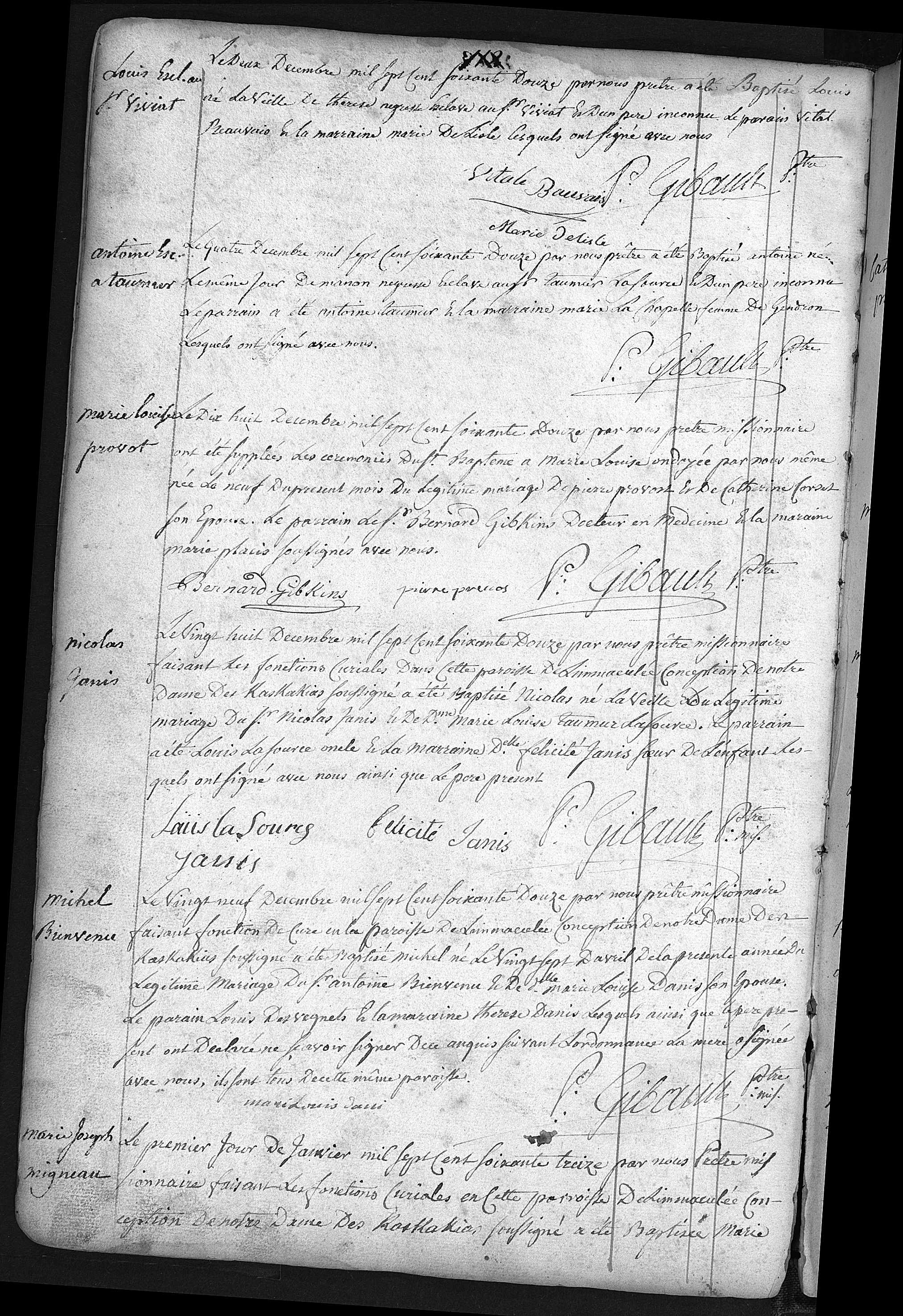
Baptismal Record for Marie Catherine

Marriage of Félicité Janis
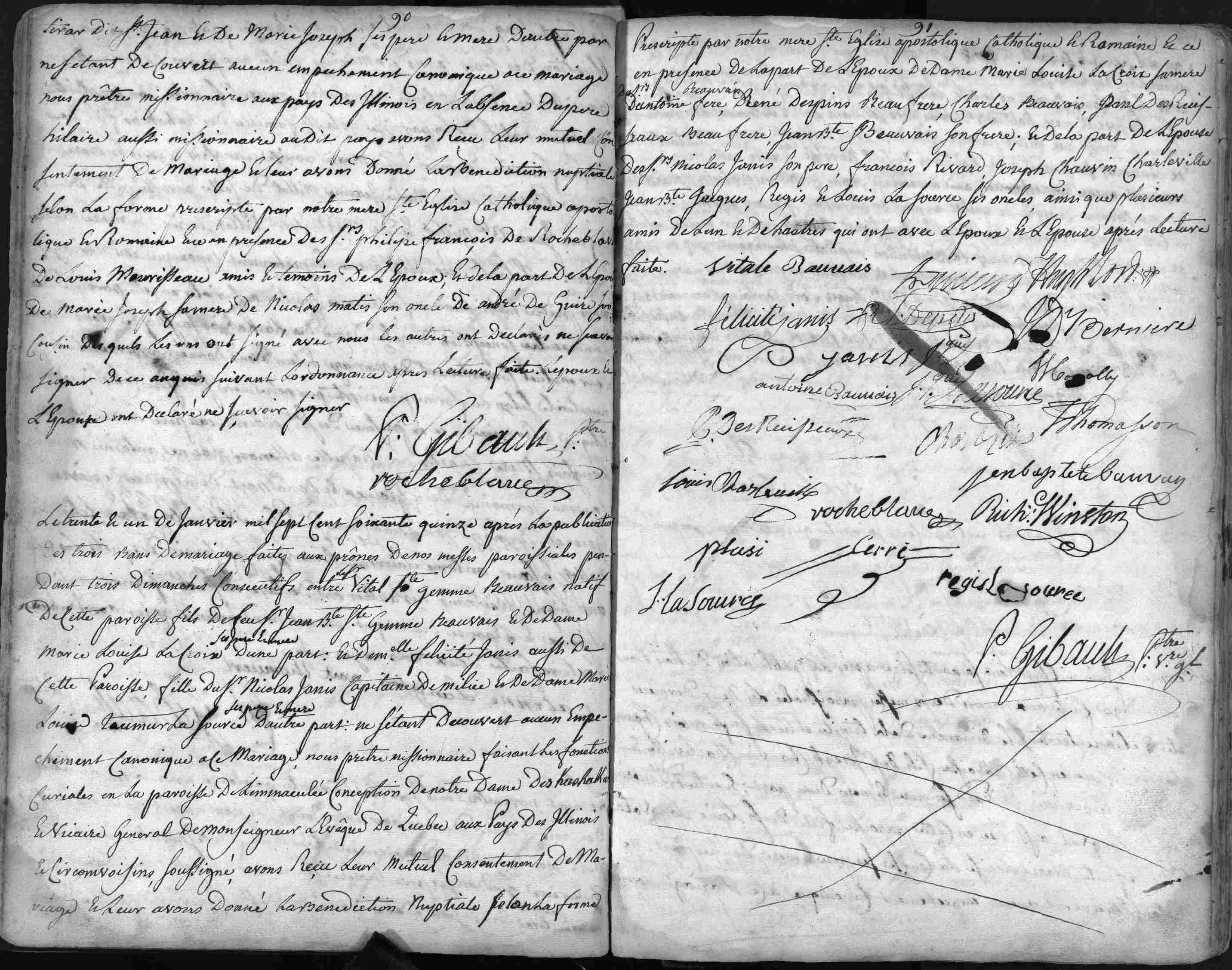
Nicolas Janis Elected Justice
Marriage of Antoine Janis
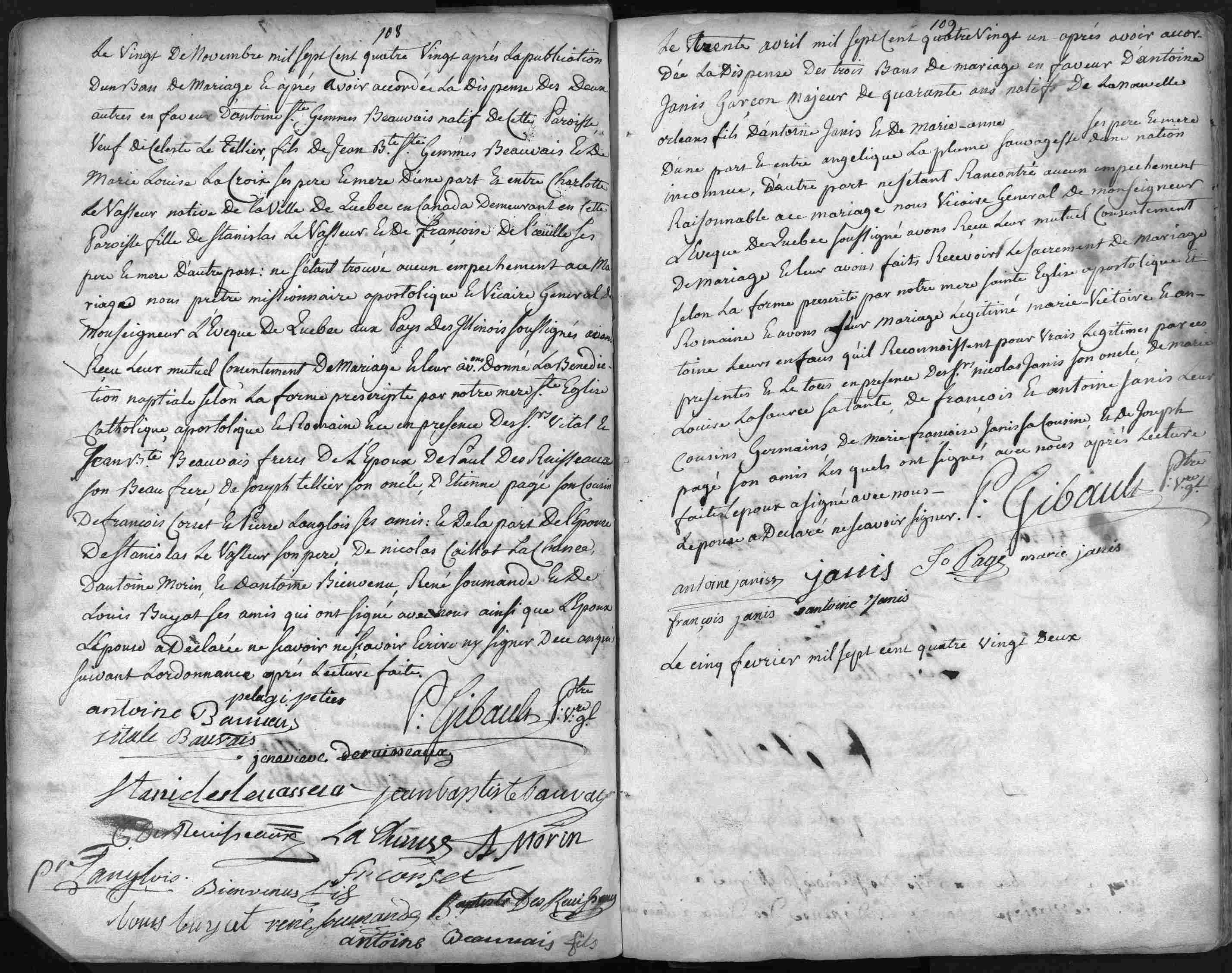
Marriage of Jean Baptiste Janis
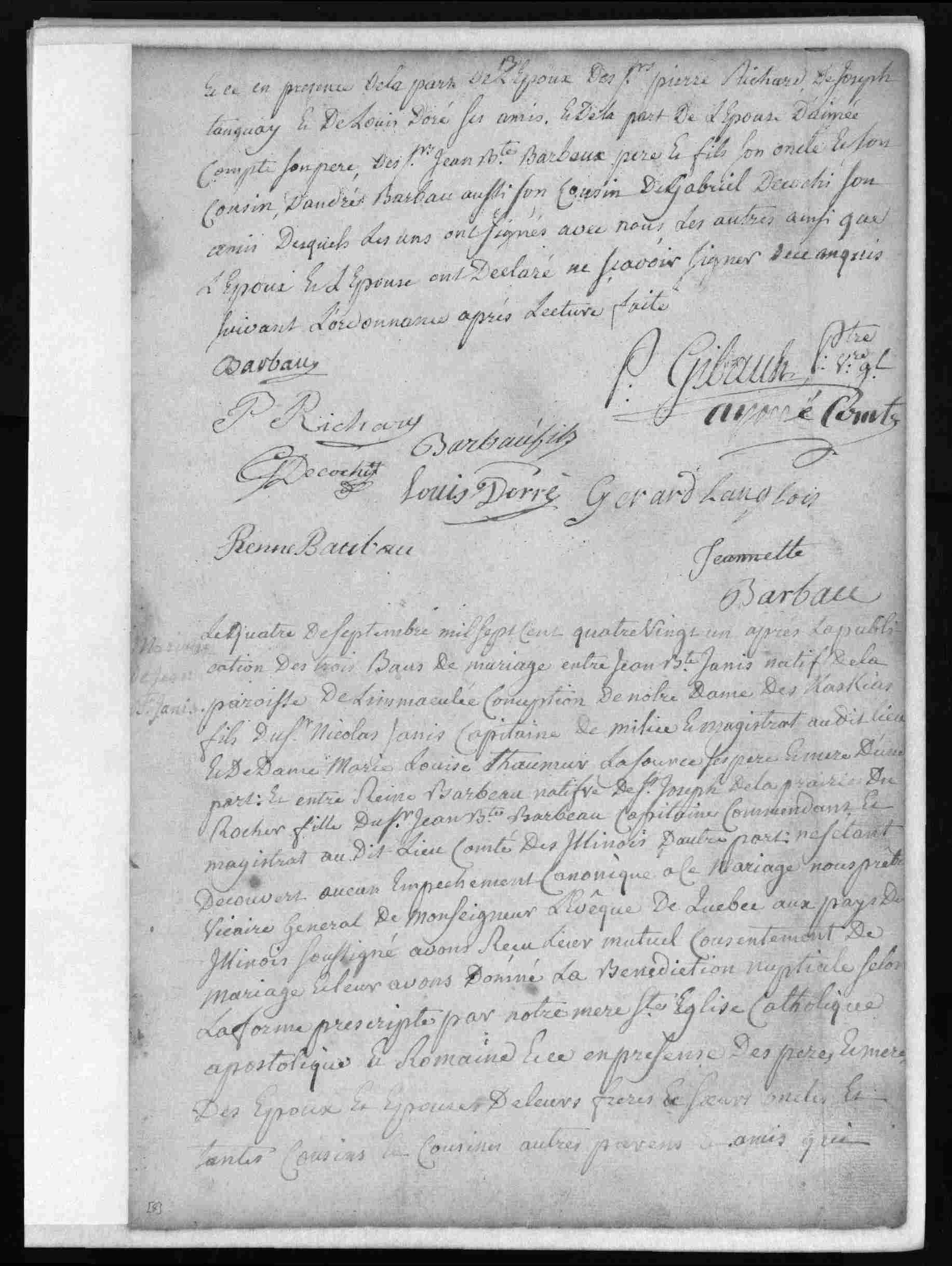
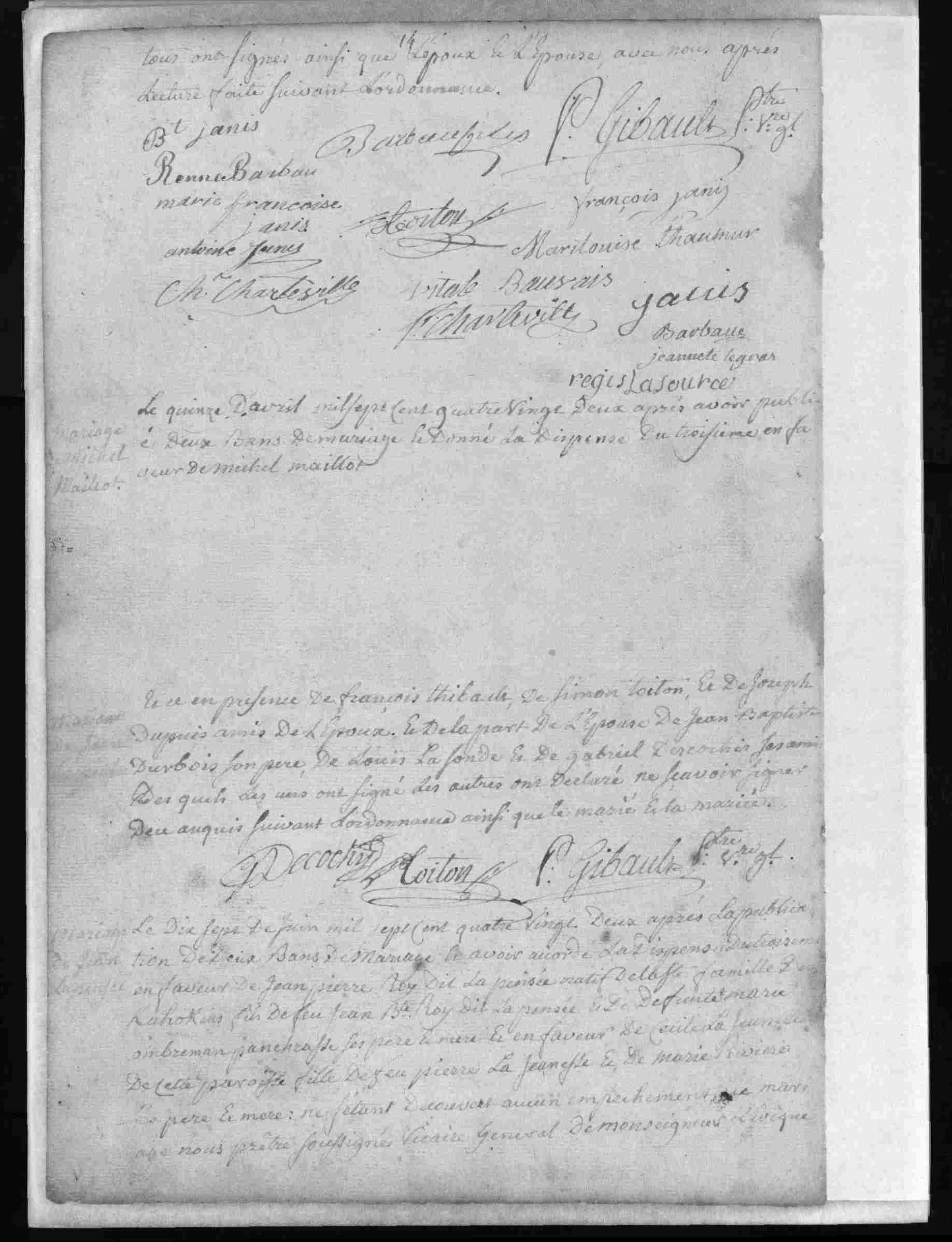
Marriage of Marie Françoise Janis

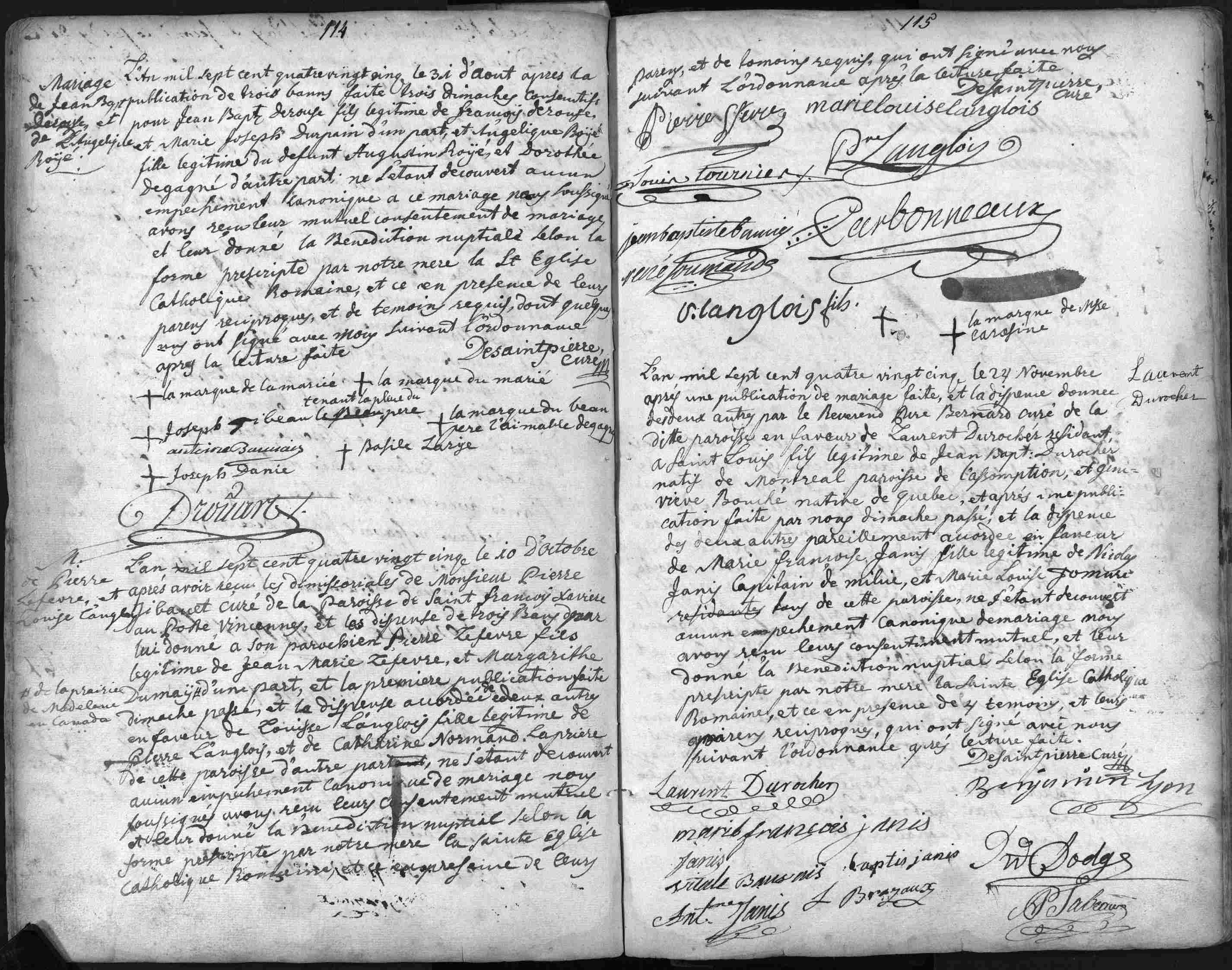
1787 Census of Kaskaskia, IL
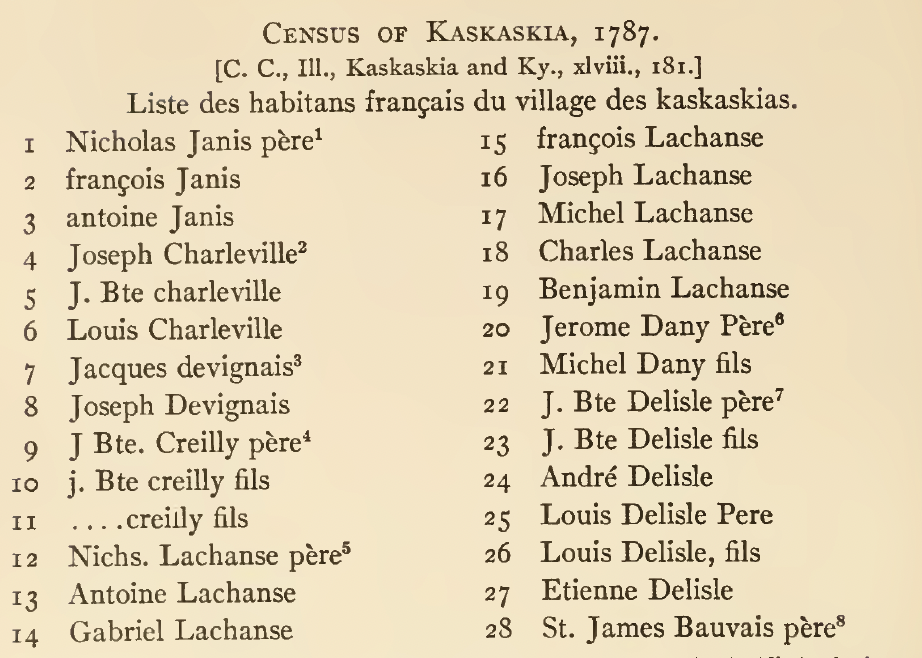
Burial of Monsr. Janis

Witness to Kaskaskia Marriage in 1773
